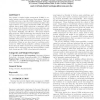Free Online Productivity Tools
i2Speak
i2Symbol
i2OCR
iTex2Img
iWeb2Print
iWeb2Shot
i2Type
iPdf2Split
iPdf2Merge
i2Bopomofo
i2Arabic
i2Style
i2Image
i2PDF
iLatex2Rtf
Sci2ools
DRM
2005
Springer
2005
Springer
Towards a software architecture for DRM
The domain of digital rights management (DRM) is currently lacking a generic architecture that supports interoperability and reuse of specific DRM technologies. This lack of architectural support is a serious drawback in light of the rapid evolution of a complex domain like DRM. It is highly unlikely that a single DRM technology or standard will be able to support the diversity of devices, users, platforms, and media, or the wide variety of system requirements concerning security, flexibility, and efficiency. This paper analyses state-of-the-art DRM technologies and extracts from them high level usage scenarios according to content consumers, producers, and publishers. In addition, the key services are identified both from a functional and security perspective. Identifying key DRM services and locating them in an overall structure brings us one step closer to a software architecture for DRM. Having available a software architecture should help the DRM community in reasoning about D...
| Added | 27 Jun 2010 |
| Updated | 27 Jun 2010 |
| Type | Conference |
| Year | 2005 |
| Where | DRM |
| Authors | Sam Michiels, Kristof Verslype, Wouter Joosen, Bart De Decker |
Comments (0)

